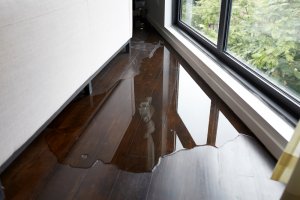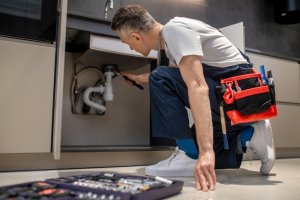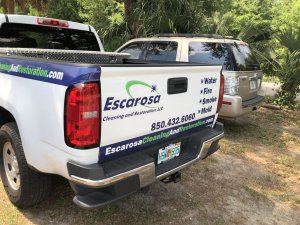Why Excess Water in Your Home is a Problem! - Escarosa

In most settings, water is a great thing. It cools us off on hot days, keeps us hydrated, and provides a beautiful vista in natural settings. One place you don’t want excess water, however, is in your home.
Humidity, plumbing leaks, storm damage, or flooding can cause a variety of issues, from damage to your home’s structure and building materials (including wood floors, window encasements, and drywall) to mold growth and pest infestations.
Fortunately, if you’re facing excess water in your home, you’re not alone.
Here at Escarosa Cleaning and Restoration, our team helps homeowners just like you navigate and control excess moisture, and restore their homes to normal.
In this blog, we’ll share a few of our top leak-detection and prevention tips, and help you learn exactly what to do if you discover a leak in your home.
Let’s dive in.
How to Detect a Leak 101
Not sure if you have a leak in your home? Look for these surprising warning signs:
1. Strange marks or blisters on your walls
Your walls could hold the first telltale signs of plumbing leaks. Water spots usually appear in walls and ceilings just below the source of the leak.
They tend to be yellow or light brown when wet, and can sometimes cause paint or wallpaper to crack or blister.
The area may also be soggy to the touch and depress easily under your fingers.
2. Low water pressure or high water bills
You turn the shower on and get nothing but a drip. You try to spray the leftovers off your dinner plate and get a drizzle. What’s going on?
If your house suddenly has very low water pressure, plumbing leaks could be the culprit. Low water pressure may indicate that there’s a leak in your system, often behind a wall.
You may also notice that your water bills are suddenly sky-high. This could be due to a leak that’s wasting water in your household.
household.
According to the Environmental Protection Agency (EPA), the average household plumbing leak can waste about 10,000 gallons of water annually. What’s more, 10% of homes have leaks that waste at least 90 gallons of water each day.
To address these problems, contact a plumber who can check your pipes and find the source of the water pressure issue. In addition to preventing future water damage, this should also start saving you some money on your water bills.
3. Drips
If you’re hearing rushing, wooshing, or dripping inside your walls or ceilings, even when the water isn’t running, it’s a sure sign of a plumbing leak. You’ll need to contact a plumber to help you pinpoint the source of the leak, and then bring in a restoration company to clean up the water damage left behind.
What to Do if You Think You Have a Water Leak or Damage
Based on the signs above, you think you might have a water leak in your home. What do you do? Keep calm and follow these steps to address excess water in your house:
1. Stop the leak if you can
If the leak is somewhere obvious, stop it at the source. Generally, you can do this by turning the water off at the source – behind a leaky sink or toilet, for example.
If the leak is hidden behind a wall or you can’t find it, you may need to turn off the water for the entire house.
No matter what, stopping the flow of water should be your first step. The faster you can stop the water, the more contained the damage will be.
2. Call a Plumber
Once you’ve stopped the leak, contact a plumber to repair it. Many plumbers offer 24/7 emergency services and will arrive quickly to locate the source of the leak and repair faulty pipes. Be aware that, while plumbers repair broken pipes and appliances, they won’t clean up the damage left behind by excess water. You’ll need to contact a remediation company for that step.
3. Call a Restoration Company
To restore your home, you’ll need the help of a comprehensive restoration company. Here at Escarosa Cleaning & Restoration, we provide complete restoration services after flood damage or storm damage.
Our team will bring in professional water extraction equipment to remove all excess water from your home and furnishings and provide top-quality drying services to remove excess moisture from the air.
If you’re concerned about mold in your home (which can form just 24-48 hours after water damage), we also provide mold detection and mold removal services.
3 Smart Steps you can Take to Avoid Leaks
When it comes to plumbing leaks, an ounce of prevention is worth a pound of cure. Follow these tips to avoid and prevent leaks in your home:
-
Reduce your water pressure. While strong water pressure is a luxury, having yours set too high could place excess pressure on your pipes. This increases the likelihood of a burst or break. To keep your pipes safe, your household water pressure should be between 40 and 85 psi.
-
Soften your water. “Hard” water (water with a very high mineral content) can be hard on your home’s pipes, resulting in plumbing leaks and decreased pipe lifespan. To reduce the mineral content of your water, install a water softener in your home. Most models use sodium to counterbalance hard minerals in the water, although some rely on electromagnetic pulses to actually dissolve minerals.
-
Invest in routine service. The best way to prevent leaks is to routinely monitor your plumbing system. Have a plumber perform routine service and evaluations on your system, and fix problems as soon as they arise.
Are You Experiencing Excess Water Damage in Your Pensacola, Florida Home? Escarosa is Here for You!

When you call Escarosa Cleaning & Restoration, we’ll arrive at your property promptly, ready to provide the expert water extraction, drying, and mold removal services you need to enjoy your home once more.
Contact us today to schedule your estimate!












